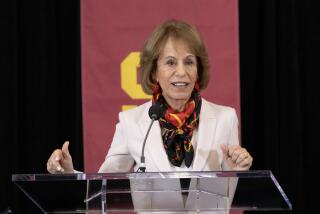USC Officials Unveiling Campaign to Raise $1 Billion by 2000 : Education: Effort has already begun, with a $120-million gift from Walter Annenberg.
- Share via
Determined to enhance USC’s academic reputation and strengthen its standing among the nation’s top colleges, officials will announce an ambitious campaign today to raise $1 billion for the school by 2000.
Among the cornerstones of the campaign are a $120-million donation received from former Ambassador Walter Annenberg and a $5-million gift to create an environmental studies institute on Santa Catalina Island.
USC officials said proceeds of the drive, whose theme is “Building on Excellence,” will be used to increase the school’s endowment for student aid, attract top-flight faculty through the creation of 100 professorships and renovate and construct state-of-the-art facilities.
“USC must attract the best scholars and students in the world and provide them with the most sophisticated classroom, research and library facilities available,” said Malcolm R. Currie, chairman of USC’s Board of Trustees. “That is what the ‘Building on Excellence’ campaign is all about.”
Today’s announcement is only the official kickoff of an effort that was quietly begun two years ago. Like other universities, USC waited to formally unveil its campaign until it had raised enough to indicate that the drive had momentum. Officials say gifts and pledges--including the 2-year-old, $120-million Annenberg donation--already exceed $405 million, or more than 40% of the $1-billion goal.
Nevertheless, USC Trustee Kenneth Leventhal, who is heading the campaign, admits that it will not be easy to get the rest of the way.
Downturns in the economy mean that some industries that have been key participants in past USC campaigns, such as real estate and aerospace, will have less money to give. Moreover, public institutions such as UCLA, with its own aggressive fund-raising machine, are competing with USC for some of the same donors.
The benefits of USC’s fund-raising campaign will extend far beyond the Trojan crimson-and-gold, said USC President Steven B. Sample. Noting that USC is Los Angeles’ largest private employer, with 17,000 workers, Sample said: “Higher education in Southern California is a bigger industry than all of aerospace.” Leventhal said he thinks some donors will be attracted by the chance to play a part in improving the city of Los Angeles.
“This billion . . . may not lead to a lot more jobs at USC, but it may lead to thousands more jobs in L.A. and Southern California,” Sample said, noting that USC does $5.4 million in business with local vendors each year.
To tap a fertile foreign market, Sample said, USC plans to seek significant financial support in this campaign from abroad, especially from Asia, which sends more students to USC than to any other American university.
In 1994 alone, Sample said, USC received $25 million in cash and pledges from donors in Asian countries. To encourage further support, the university will open three regional offices in Asia during the coming year to handle fund raising, alumni relations and student recruiting and provide the parents of current USC students with more information about the school.
USC is among the nation’s top dozen private universities in funded research and was honored last year when chemistry professor George Olah won a Nobel Prize for his work with hydrocarbons. The school has become more selective in its admissions over the years, Sample said, and has produced eight winners of the prestigious Rhodes scholarships.
“USC has increased its competitiveness dramatically in terms of attracting more and more of the very best students,” Sample said, noting that entering freshmen today score more than 100 points higher on scholastic aptitude tests than freshmen did 10 years ago.
Nevertheless, when a comprehensive survey of the nation’s doctoral programs was released earlier this week, USC had only one program that was ranked in the top 10--its electrical engineering program, which tied for 10th place with UCLA.
“We’re trying to develop programs that are truly, in their respective areas, the best in the world,” Sample said. “I think this campaign will make us even more competitive.” Already planned is the creation of a $60-million environmental studies institute, launched with a $5-million gift from William and Julie Wrigley. The project on Santa Catalina Island will be developed in phases between now and 1999, and will incorporate an existing USC research facility on the mainland side of the island.
It will aim to provide students with a high-quality natural laboratory in which worldwide environmental issues can be studied hands-on. “We’re hoping to get students involved in the real world,” said Morton Schapiro, dean of USC’s College of Letters, Arts and Sciences.
Timing of the gift could not be better, Schapiro said. Last year, USC created an environmental studies program that has already attracted more than 100 majors.
The $120-million Annenberg donation, which in 1993 was the largest gift in the history of higher education, has already been used to establish the recently opened Annenberg Center for Communication.
Times education writer Richard Lee Colvin contributed to this story.






